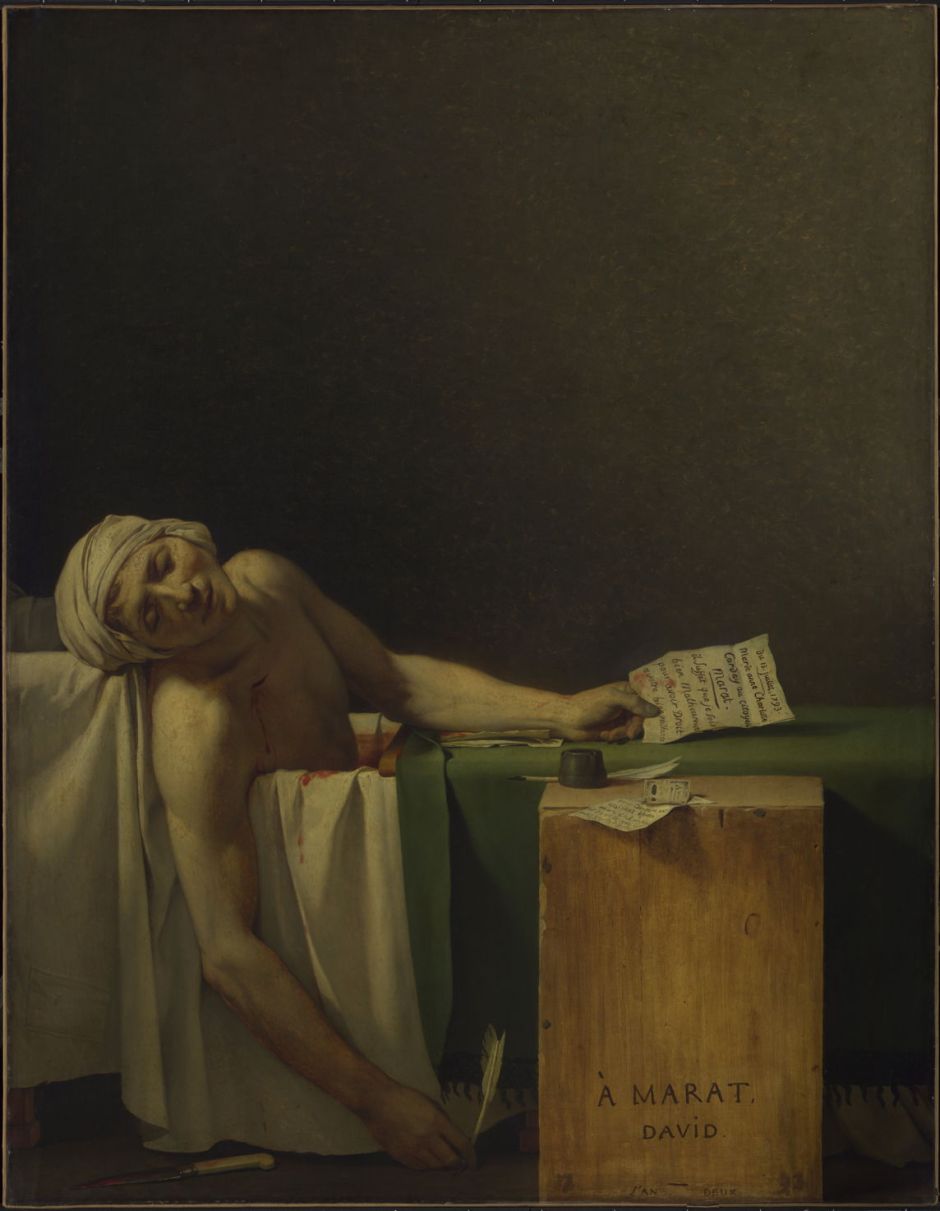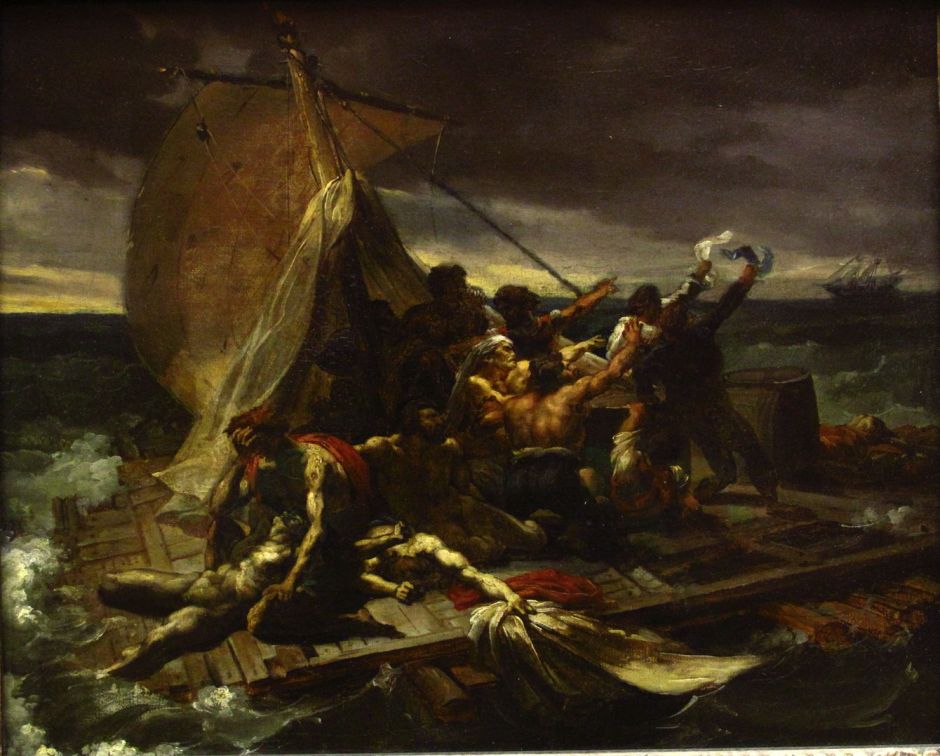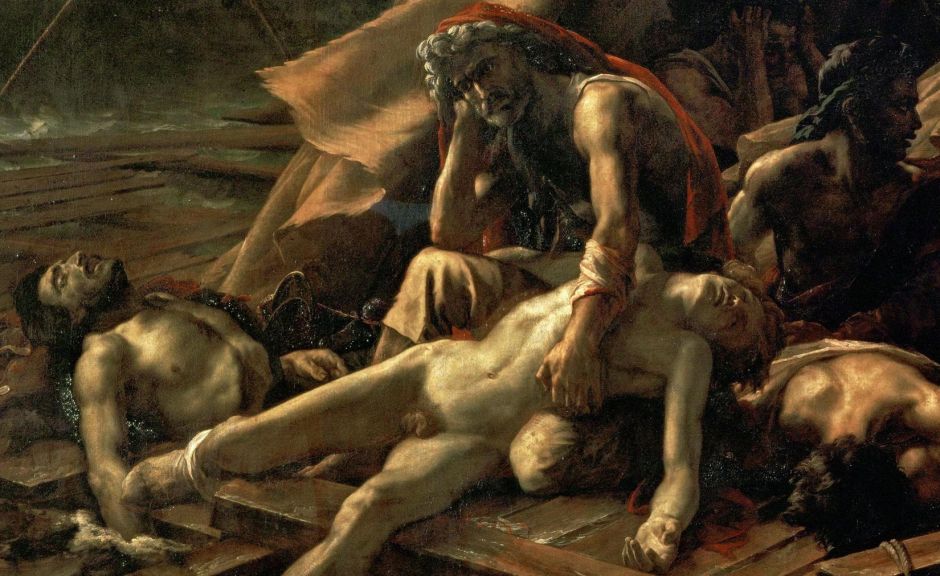I don’t usually celebrate the anniversaries of individual paintings, but this year there’s one which merits it, as it was responsible for changing the course of painting during the nineteenth century. It was also painted by an artist whose other works are largely forgotten. This revolutionary painting is Théodore Géricault’s massive Raft of the Medusa, completed and exhibited in 1819.
This first article of two considers history painting before this work, the underlying story, and how Géricault painted what he did. Tomorrow’s sequel will explain its reception and effect on art.
The idea of painting historical events goes back to the dawn of painting, but such works were only seldom intended to be any form of visual record of what actually happened. Renaissance battle scenes, for example, were composed as works of art, and the artist was rarely an eye witness, or undertook research to establish what the scene might have looked like. Even gross anachronisms, such as the use of cannons before gunpowder had been introduced to Europe, were acceptable.
West and modern history
One of the first painters to consciously make an effort at fidelity was Benjamin West (1738–1820), who ended up in a row with the influential Joshua Reynolds over how he should paint contemporary history.
West intended to paint a scene from an almost uniquely brief battle between British and French forces on 13 September 1759, which lasted just an hour or so. At the end of their three months seige of the French city of Quebec, Canada, British forces under the command of General Wolfe were preparing to take the city by force. The French attacked the British line on a plateau just outside the city.
Within minutes, General Wolfe suffered three gunshot wounds, and died quickly from them. The French commander, General Louis-Joseph, Marquis de Montcalm, was also hit by a musket ball, and died the following morning. The British line held, and the French were forced to evacuate the city, which ultimately led to France ceding most of its possessions in North America to Britain, in the Treaty of Paris of 1763. Wolfe’s death was quickly seen as the ultimate sacrifice of a commander in securing victory.

West’s painting uses a formal composition in three groups, arranged in a line across the foreground, with the dying general at their centre. The central group has common compositional features with scenes painted of the crucifixion of Christ, and is often considered to be modelled after a ‘Lamentation’ or pietà, although there are obvious differences in the people present (the Marys are central), their positions (there are commonly figures at the foot, and cradling the upper body), and most significantly in the fact that, at that stage, Christ’s body is limp and lifeless.
The argument centred on West’s choice of a subject from very recent history, and his claim that he was put under pressure by Joshua Reynolds to dress its figures in classical Roman clothing. In Galt’s biography of West, he gives these words as being West’s own:
“When it was understood that I intended to paint the characters as they had actually appeared in the scene, the Archbishop of York called on Reynolds and asked his opinion, the result of which was that they came together to my house.”
West is reported as saying that Reynolds “concluded with urging me earnestly to adopt the classic costume of antiquity, as much more becoming the inherent greatness of my subject than the modern garb of war.”
Of course West didn’t actually attempt to produce a visually accurate record, but an image which was an artistic interpretation of a real event. The next step towards modern history painting was taken by Jacques-Louis David (1748–1825), in his account of Marat Assassinated from 1793.
David as eye witness
Marat was a leading member of the Revolutionary movement in France, an influential journalist through his newspaper, and a friend of David, who had become embroiled in Revolutionary politics. Because of a severe skin disease, Marat spent much of the time in a bath to ease the intense itching. On the morning of 13 July 1793, Charlotte Corday, a young woman from Normandy, turned up at Marat’s house in Paris, asking to see him; his fiancée turned her away. She gained entry that evening, and started to give Marat the names of some local counter-revolutionaries. While he was writing them down, she drew a kitchen knife with a 15 cm (6 inch) blade from her clothing, and plunged it into Marat’s chest, killing him very quickly.
Corday admitted if not boasted of her actions, and on 17 July she was executed in public by guillotine. Marat became a martyr for the cause, after his friend David had organised his spectacular funeral, and an enduring painted memorial.

David shows Marat’s body slumped over the side of his bath, the murder weapon and his quill both on the floor, the pen still in his right hand, and a handwritten note in his left hand. Corday’s note gives the date, and addresses itself from her to Citizen Marat. It opens with “It suffices to say that I am very unhappy to qualify for your kindness”.
This sparse and simple painting became the quintessential image of The Terror in particular, and the Revolution as a whole. Although still a combination of artistic interpretation, reality as seen this time by an eye witness, and more than a little political propaganda, it appears to have a documentary quality: a painting as a visual record of contemporary history.
Shipwreck
In 1816, France was a nation in turmoil. Crushed militarily at the Battle of Waterloo the previous year, Napoleon’s empire had collapsed, and the rest of Europe had restored the rule of Louis XVIII, reverted the country’s boundaries to those of 1789, and were occupying the country until it paid a war indemnity.
In June 1816, the French Naval frigate Méduse (Medusa) sailed as the lead of a small group to accept the return of French Senegal from the British, as part of the peace process. She was under the command of Viscount de Chaumereys, who had had little experience at sea over the previous twenty years, but had been preferred as a result of political policy.
The Méduse overtook the other ships instead of sailing in company, and the captain’s poor navigation took it more than a hundred miles off course, to run aground on a sandbank off the coast of West Africa on 2 July. The decision to abandon the vessel was taken on 5 July, but with four hundred souls on board and capacity for only around 250 in the ship’s boats, at least 146 men and one woman were put on board a raft which was built hastily for the purpose.
Although the ship’s boats had originally intended to tow the overloaded and partially-submerged raft, it was cut loose after only a few miles. The survivors on the raft then had little to keep them alive: a bag of ship’s biscuits which were eaten on the first day, two barrels of water which were soon lost overboard, and six of wine, hardly suitable to prevent dehydration. Over the following thirteen days, most died or were killed, leaving just fifteen alive when they were spotted by the Argus, a brig from the same group bound for Senegal.
Some of the survivors wrote a detailed account which was published in 1817, and deepened the embarrassment caused to the newly-restored French monarchy. What should have been a routine step in restoring a French colony became a lasting matter of shame in the press, and public debate.
Research
In the winter of 1817-18, when Géricault must have decided to paint this disaster, he would have recognised the two changes of fortune (moments of peripeteia) in the story: the abandonment of the Méduse, and the rescue of the few survivors remaining in the raft. Classically, the best depictions of shipwreck and rescue have chosen the latter as preferable, as it shows both the result of the gruelling period of survival and the imminent hope of being saved. Géricault may also have considered this a parallel with that moment in the history of his nation.
During the spring and summer of 1818, Géricault worked on accumulating the information which he needed for the painting. He spent a long time talking to survivors, notably Savigny and Corréard, the principal authors of the book about the incident, and studied popular lithographs which were being produced illustrating it. Of the three example illustrations included in Eitner’s monograph about this painting, one showed the abandonment, one a mutiny on board the raft, and the last the sighting of the rescue ship.

He sketched various moments during the disaster, gradually honing in on the moment of rescue. This drawing shows one of the ship’s boats from the Argus reaching the raft, for example, and Géricault drew each event from the mutiny through to the raft being left empty once everyone had been rescued. Note that in this sketch, the raft is shown as a long rectangle rather than a square.

Once he had selected the second moment of peripeteia, when the survivors first sighted the Argus, he then worked through different compositional options, resulting in an initial compositional study in oils.

He continued to develop from this, probably completing these preparations during the autumn of 1818.
Attention to detail
In this period of almost a year devoted to preparatory work, Géricault accumulated a great deal of information about the disaster. He had enlisted the help of another of the survivors, a carpenter, in constructing props for his studio painting. As figures resolved for inclusion in the work, he made detailed studies of those elements in readiness for painting.

This study shows one of the figures, known as “the Father”, from the group named “the Father holding his dead son”, seen below in the finished painting.

Géricault visited morgues to make studies of cadavers and body parts. When he came to paint individual figures, he carefully selected some of sickly appearance, including the young artist Eugène Delacroix, who was ill with jaundice at the time.

In contrast to his previous studies, though, for the finished work he decided to make the Argus so tiny that this most important element in the whole composition was also its smallest.
The finished work

The end result is a vast canvas, its figures shown life-sized, which has had huge impact on everyone who has seen it since 1819. It appears completely authentic, and given the work that Géricault put into making it so, that’s perhaps not surprising. But most gain the impression that the raft was almost square in form, as a result of the tight cropping applied, and that even with those few survivors on board, it was overcrowded. This is because Géricault chose to pack all his figures into one small section of the raft.
References
Shipwrecked art history: Géricault’s Raft of the Medusa
Athanassoglou-Kallmyer N (2010) Théodore Géricault, Phaidon Press. ISBN 978 0 7148 4400 8.
Eitner L (1972) Géricault’s Raft of the Medusa, Phaidon Press.

